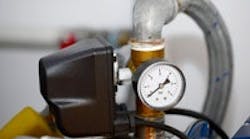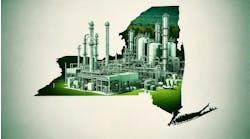Air, a much-used "free" utility in processing plants, still requires substantial amounts of money to run compressors and fans. Often, however, sizable savings are possible — for instance, one plant saved $500,000/year, as a success story from the U.S. Department of Energy illustrates.
[pullquote]
Solutia produces a full range of nylon products at its Greenwood, S.C., plant. The vertically integrated facility operated four separate compressed air systems, each with its own pressure level (225, 120, 115, and 90 psig) and dedicated compressors, controls and air treatment equipment.
The 225-psig system alternated two 500-hp centrifugal compressors that generated 1,509 scfm, each at 230 psig. The 120-psig system used two 800-hp centrifugal compressors that generated 3,200 scfm, each at 135 psig. The third system used two 800-hp compressors that generated 2,700 scfm, each at 125 psig. The lowest pressure system used six compressors (five centrifugal and one rotary screw) that produced 16,000 scfm at 100 psig. The 225-psig system had a back-pressure letdown valve to release excess air into the 100-psig system. A total of 12 compressors (11 centrifugal and one rotary screw) used 9,500 hp. Typically, the plant operated nine of the 12 compressors, totaling 7,200 hp, producing an average of about 20,500 scfm.
The plant was beset with moisture carryover that negatively affected product quality. In response to this and high compressed-air costs, plant engineers commissioned a two-stage, system-level evaluation by independent consultants to devise a plan to eliminate moisture contamination and reduce energy consumption.
The evaluation first focused on the supply side. It revealed three situations that caused the moisture carryover, as well as other inefficiencies, and provided a system-level strategy to address them. Moisture carryover mainly came from the 100- and 125-psig systems. The systems' aftercoolers were unable to lower the air temperature to 100°F — the level that would allow the dryers to remove the moisture — due to insufficient flow of chilled water and fouling in the aftercoolers' heat-transfer surfaces. The 100-psig system's receivers located before the dryers were found to be undersized. These receivers couldn't remove liquid from the air during demand spikes and released higher volumes of air into the dryers, leading to incomplete drying. In addition, the desiccant beds in the dryers were saturated and had become ineffective in removing moisture.
The survey also revealed excessive pressure drop in all four systems, causing pressure levels to fluctuate — leading to higher-than-normal discharge pressure, which wastes energy and increases operating costs. The 230- and 135-psig systems experienced high pressure drop across the dryers. The 115- and 90-psig systems had pressure drops of 13.9 psi and >15 psi. The 225- and 125-psig systems experienced 3.9-psi and 6.3-psi pressure drops. Overloaded dryers, various isolation and switching valves, hot taps, orifice plates, and cleanup equipment contributed to excessive pressure drop in the 90-psig system. In addition, in one sector of the plant, separate headers didn't allow the most optimal flow rate and contributed to pressure loss in that area.
The survey also identified excessive compressor blowoff in three of the four air systems. Most of the plant's centrifugal compressors function efficiently when they're fully loaded, with inlet valves fully open, and discharge pressures close to their design pressure. Centrifugal compressors have limited throttling capacity and could shut down if they can't vent enough excess air to prevent the system pressure from rising above their set points. Hence, they need to vent compressed air when the system demand falls below the compressors' minimum stable flow. Similarly, when air demand increases, the system automatically would start an additional centrifugal compressor to maintain pressure levels. The compressors' limited partial loading capability led to system blowoff mode. The 225-psig system vented 600 scfm (40% of the output) because the inlet valve was partially closed. The 125-psig system vented 1,800 scfm (60% of the output) because it didn't have a letdown valve. In the 90-psig system, one of the 1,000-hp compressors had extensive blowoff most of the time it operated. Altogether, about 25% of air produced was blowing off into the atmosphere.
The survey also found that the 90-psig system's control settings on the 1,000-hp compressors weren't uniform, leading to uneven performance and loss of compressor capacity. One of these compressors only delivered 842 hp and produced a constant whining sound. In the 115-psig system, the controls gradually throttled the compressors down followed by a rapid return to full load.
In the next column we'll cover the actions the plant took after it identified these problems.
Source: Project Fact sheet, Office of Industrial Technologies, Energy Efficiency, U.S. DOE



